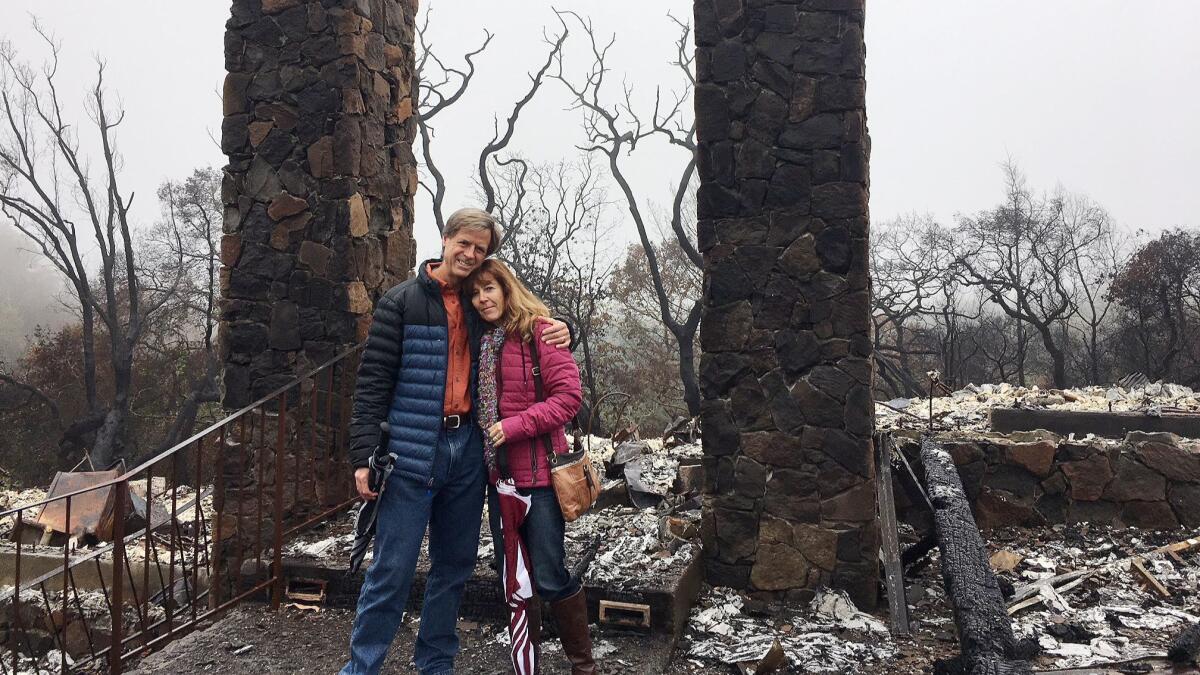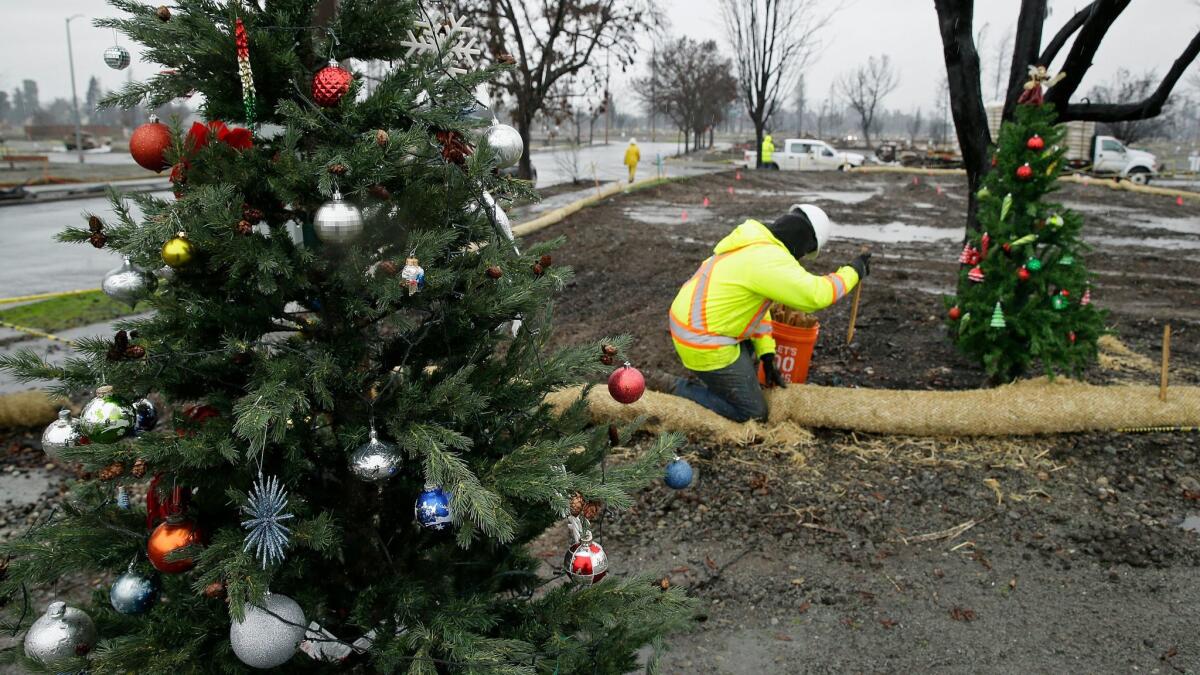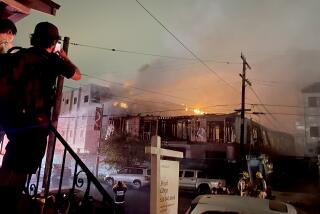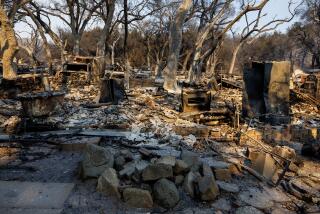Northern California wildfire victims learn ‘your insurance company is not your friend’

Reporting from SANTA ROSA, Calif. — Four months after a ferocious firestorm devastated communities in California’s wine country, those who lost their homes are still struggling.
Animal feeding stations remain on roadsides, monitored by volunteers searching for pets left behind when their owners fled. Cats that had been feared dead continue to be found.
Signs are everywhere, advertising the services of contractors, engineers, debris removers and lawyers. Many burned homes have yet to be cleared.
The shock and horror of the early days have given way to lingering grief and agony over whether to rebuild or move on. But the most perplexing and time-consuming matter for victims has been insurance.
More than 8,000 homes and other buildings were lost in the fires that swept through Napa, Sonoma and Mendocino counties. Forty-four people died. Because of failed communications, some residents had only minutes to escape.
Laurie Lamantia, 58, whose house was left uninhabitable by the fire, said she is constantly having to fight her insurance company to get what is owed her.
She said she spends at least eight hours a day dealing with insurance matters, documenting every conversation and following every meeting and phone call with an adjuster with a written note.
“Your insurance company is not your friend,” Lamantia said when asked what advice she could give to the victims of the more recent Southern California fires that destroyed about 1,000 homes. “They are going to be really nice and tell you they want to take care of you, but they are not your friend.”
She and other fire victims here have written letters and made calls to their elected representatives. They study the websites of a group called United Policyholders and the state Department of Insurance and contact them with questions and complaints.
“The most important thing people can do is unite,” Lamantia said.
New legislation in Sacramento
Pressure from the community has spurred legislative proposals in Sacramento to make it easier for victims to recover from insurance companies.
A lawsuit filed this month accused the Department of Insurance of failing to ensure that out-of-state adjusters registered with the state and worked under supervision of a manager who knew California law.
Several fire victims complained in interviews that adjusters who poured in from other states to help companies process claims misinformed policyholders about their rights.
Jeff Sengstack, 68, a plaintiff in the lawsuit, lost his home in a hilly, woodsy neighborhood near Santa Rosa.
He and his wife, Birgit, 53, were awakened by a neighbor pounding on their front door in the early hours of Oct. 9.
Jeff Sengstack looked out his window and saw a wall of orange. He and his wife loaded their two cockatiels, one of their cats, photographs and hard drives into their cars.
In their driveway, Birgit Sengstack tried unsuccessfully to summon their second cat. She said a whipping wind roared “like a monster” and tornadoes of flames swirled closer and closer.
Explosions from burning tanks and cars sounded like thunder, she recalled, and embers rained from the sky. She was afraid her hair and clothes would catch fire.
A neighbor’s video recording shows that two minutes after the couple pulled out of the driveway, their home of 18 years was engulfed in flames. Three minutes later, the house was gone.
Still shaken and emotional, Jeff Sengstack said he met a few days later with an independent adjuster who had arrived from Alabama.
The adjuster, apparently unaware of the wording of the Sengstack policy, asked him if he wanted to be put up in a hotel or an apartment.

Sengstack, a former journalist who now creates online video tutorials, knew he was entitled to 24 months of housing comparable to the home that burned, not just a hotel room or an apartment.
“I thought then, this man is my enemy, my adversary,” he said.
He said the adjuster was among hundreds, mostly from the South, who flooded the region after the fires.
Most failed to register, worked unsupervised and did not know California law, which is more protective of policyholders than rules in other states, the lawsuit said.
Nancy Kincaid, a spokeswoman for the Department of Insurance, said the agency is already investigating whether unregistered and unsupervised adjusters worked the Northern California fires. She said she could not comment on what the “confidential” probe has found so far.
Like many others who lost their homes, the Sengstacks have not decided whether to rebuild.
Black, skeletal oak trees dot their five-acre hilltop property. Two stone pillars mark the entry to what had been their home, now a jumble of ash, shattered glass and scorched wood and metal.
The views, once breathtaking, show the ravages of fire — “depressing as hell,” Sengstack said.
But Birgit Sengstack said they could never find another home like their old one. She pointed to a blackened oleander bush alongside what had been their driveway.
If cut back, it might yet grow, she said. Her husband looked dubious. “I have hope,” she insisted, examining the blackened leaves.
The couple said insurance proceeds would not be enough to replace the home they had, though they could build something smaller.
Because of so much demand, the cost of housing and construction has been rising since the fires. Just getting an appointment with a contractor can be challenging.
Jeff Sengstack still weeps when he talks about the fire, but the couple is slowly starting to heal. Their second cat was discovered alive in their old neighborhood two and a half months after the fire.
Claude Corvino, whose house also burned down, said cost was only one factor in deciding whether to rebuild. He said his wife worried that she would never feel safe.
“This will happen again,” said Corvino, 64, who owns an engineering company.
The last time was 53 years ago. There were fewer homes back then.
In Coffey Park, a middle- and working-class development in the flats of Santa Rosa, most of the lots have been cleared of debris, and one house is almost ready for occupancy.
Owners of the more than 1,300 tract homes that burned there have tried to be strong in the face of the devastation.
Some returned to their burned-out lots to put up Christmas trees and other decorations during the holidays.
A group even went caroling, singing in front of houses that existed only in memory.
Lawsuit says out-of-state adjusters gave out bad info
Jon B. Eisenberg, 64, a lawyer who lives in Sonoma County, volunteered at a center to help fire victims understand their insurance policies.
Eisenberg and his wife lost their house in the Oakland hills firestorm of 1991, and the October blaze came so close to their home in Healdsburg that they had to prepare to evacuate.
He sued the Department of Insurance with Sengstack after speaking to dozens of victims whose adjusters, he said, clearly did not know California law.
The suit said adjusters inaccurately told fire victims they would not receive full replacement cost benefits unless they rebuilt in the same location and gave them wrong time frames for collecting full replacement benefits and for recovering additional living expenses.
“My distress turned to anger when I realized how much misinformation was out there,” Eisenberg said.
He called the Department of Insurance to complain.
Insurance Commissioner Dave Jones issued an advisory in November warning insurance companies to ensure their adjusters knew California law. He later persuaded insurance companies to make it easier for victims to be reimbursed for lost contents.
But Eisenberg, whose suit does not seek monetary damages, wants the department to enforce the insurance rules more zealously, either by fining companies or obtaining a court order requiring adjusters to be supervised.
Janet Ruiz, the California representative for the Insurance Information Institute, an industry trade association, said she believed the industry did register its out-of-state adjusters.
Though policyholders may have received some misinformation early on, that was quickly rectified, she said. She also cautioned that treating an insurance representative as an adversary “doesn’t get you the best result.”
“What gets you the best result is being informed and negotiating smartly,” she said.
Adjusters who work catastrophes tend to be “extremely compassionate because they do this all the time,” Ruiz said.
Lamantia’s impression was different.
Fourteen days after the fire, Lamantia met with an adjuster and told him her family had incurred $3,000 in expenses after evacuating with only the clothes they wore.
“He looked at me as if I had been shopping at Nordstrom,” she said. “Then he turned to another adjuster and said, ‘We are here for the needy, not the greedy.’ ”
Lamantia was taking notes and jotting down names.
Twitter: @mauradolan
More to Read
Sign up for Essential California
The most important California stories and recommendations in your inbox every morning.
You may occasionally receive promotional content from the Los Angeles Times.











